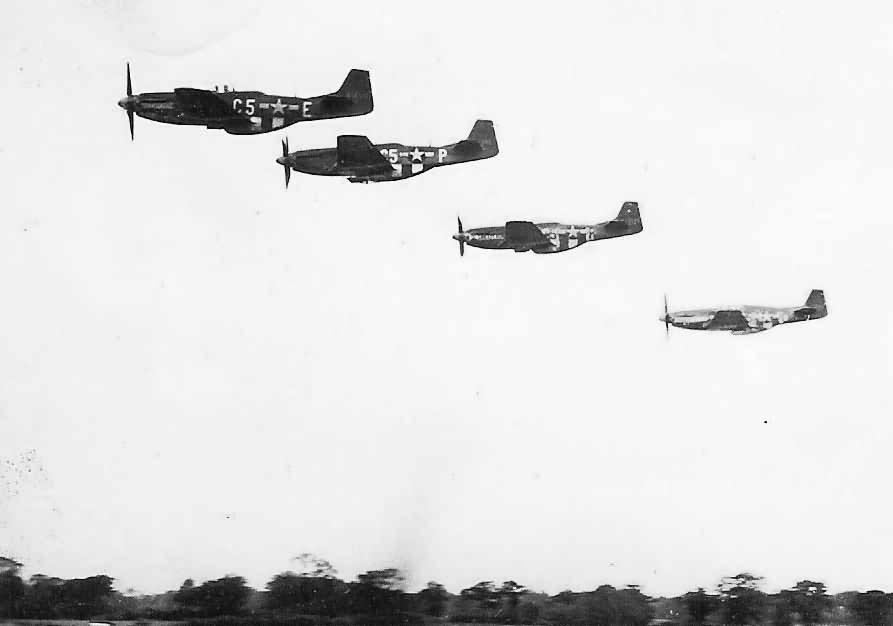The 357th Fighter Group was one of the most distinguished units of the U.S. Army Air Forces during World War II. Known for its impressive combat record, particularly in air victories, it was the first group in the Eighth Air Force to fly the P-51 Mustang. Here’s a detailed overview of the group’s history and key details:
Assignments:
- Eighth Air Force: Assigned on 31 January 1944.
- 66th Fighter Wing (VIII Fighter Command): From 31 January 1944.
- 66th Fighter Wing (3rd Bombardment Division): From 15 September 1944.
- 66th Fighter Wing (3rd Air Division): From 1 January 1945.
Component Squadrons:
- 362nd Fighter Squadron
- 363rd Fighter Squadron
- 364th Fighter Squadron
Combat Aircraft:
- P-51B Mustang: From block 1.
- P-51C, D and K Mustang
Stations:
- Raydon: 30 November 1943 – 31 January 1944.
- Leiston: 31 January 1944 – 8 July 1945.
Group Commanding Officers (COs):
- Lt Col Edward S. Chickering: 7 July 1943 – 17 February 1944.
- Col Henry R. Spicer: 17 February 1944 – 5 March 1944 (POW).
- Col Donald W. Graham: 7 March 1944 – 10 October 1944.
- Lt Col John D. Landers: 11 October 1944 – 2 December 1944.
- Col Irwin H. Dregne: 2 December 1944 – 21 July 1945.
Mission History:
- First Mission: 11 February 1944.
- Last Mission: 25 April 1945.
- Total Missions: 313.
- Aircraft Missing in Action (MIA): 128.
- Enemy Aircraft Claims: 609 in air combat; 106 on the ground.
Major Awards:
- Distinguished Unit Citations:
- 6 March 1944 and 29 June 1944: For defending bombers on missions to Berlin and Leipzig.
- 14 January 1945: For action during the Derben mission.
Claims to Fame:
- First P-51 Mustang group in the Eighth Air Force.
- Achieved the fastest rate of air victories among all Eighth Air Force groups during the final year of the war.
- Highest single-mission air victory claims: 56 enemy aircraft shot down on 14 January 1945.
History and Early Developments:
- Activated: 1 December 1942 at Hamilton Field, California.
- Initially trained with P-39 Airacobras at Tonopah Army Air Field, Nevada, before transitioning to P-51 Mustangs.
- Overseas Movement: Left Casper Army Air Field, Wyoming, for Camp Shanks, New York, and sailed on the Queen Elizabeth on 23 November 1943, arriving in Clyde on 29 November 1943. Initially assigned to the Ninth Air Force and based at Raydon before transitioning to the Eighth Air Force in January 1944.
Aircraft Markings:
P-51B/C/D/K Mustangs (January 1944 – July 1945):
- Initial Markings: The original P-51Bs were factory-finished in Dark Olive Drab and Neutral Gray with white type identity bands and squadron codes: G4 (362nd), B6 (363rd), and C5 (364th).
- Nose Marking (March 1944): The group adopted a distinctive nose marking with the spinner divided into alternating red and yellow bands and the adjacent cowling featuring a 12-inch band with two rows of alternating 6-inch red and yellow squares.
- Camouflage (April 1944): Received bare metal-finish P-51Bs, which were later field-camouflaged in dark green (upper surfaces) and light grey (lower surfaces), often using RAF paints.
- Late War Markings: By September 1944, field camouflaging was discontinued. Rudders of the 363rd Fighter Squadron were painted red, and the 364th’s rudders were yellow, while the 362nd’s remained silver or camouflaged.
